The Role of Poor Recruitment Decisions on Performance Analysis
VerifiedAdded on 2020/05/11
|17
|4203
|485
Report
AI Summary
This research proposal investigates the significant role of poor recruitment decisions in influencing organizational performance. It explores the adverse effects of inadequate hiring practices on employee productivity, business development, and overall organizational success. The study aims to identify the key relationships between poor recruitment decisions and workforce performance, examining how these decisions impact an organization's efficiency and goodwill. The research employs a mixed-methods approach, combining qualitative and quantitative data collection to analyze the research problem. The proposal outlines a detailed methodology, including the use of inductive reasoning and a mixed research design, to gather and analyze relevant data. It also reviews the conceptual framework, incorporating theories such as equity theory, human capital theory, and resource-based view theory to provide a comprehensive understanding of the issue. The research is justified by its potential to provide insights into improving recruitment strategies and mitigating the negative impacts of poor hiring decisions. The potential outcomes include the development of actionable recommendations for human resource managers, emphasizing the importance of effective recruitment and selection processes to enhance organizational performance.
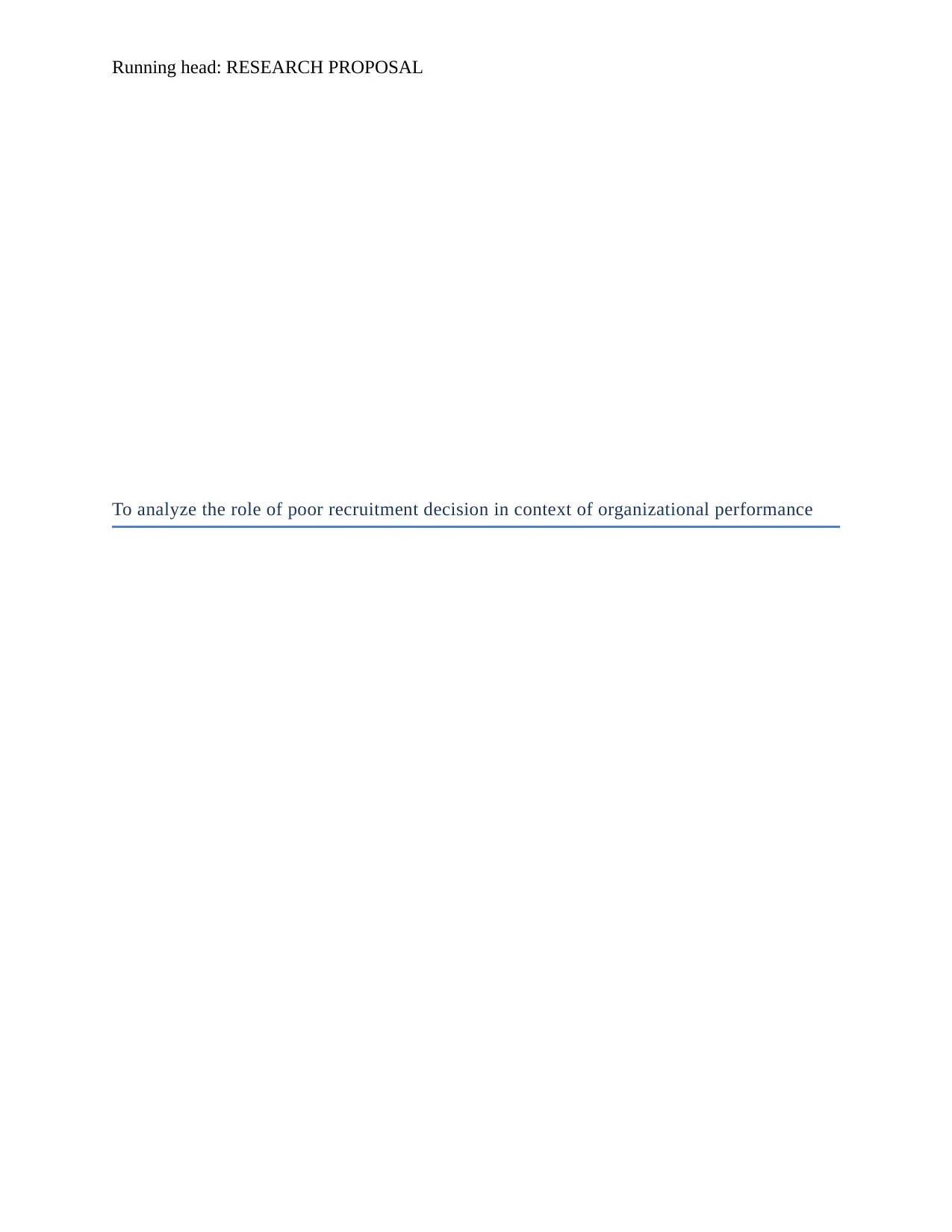
Running head: RESEARCH PROPOSAL
To analyze the role of poor recruitment decision in context of organizational performance
To analyze the role of poor recruitment decision in context of organizational performance
Paraphrase This Document
Need a fresh take? Get an instant paraphrase of this document with our AI Paraphraser
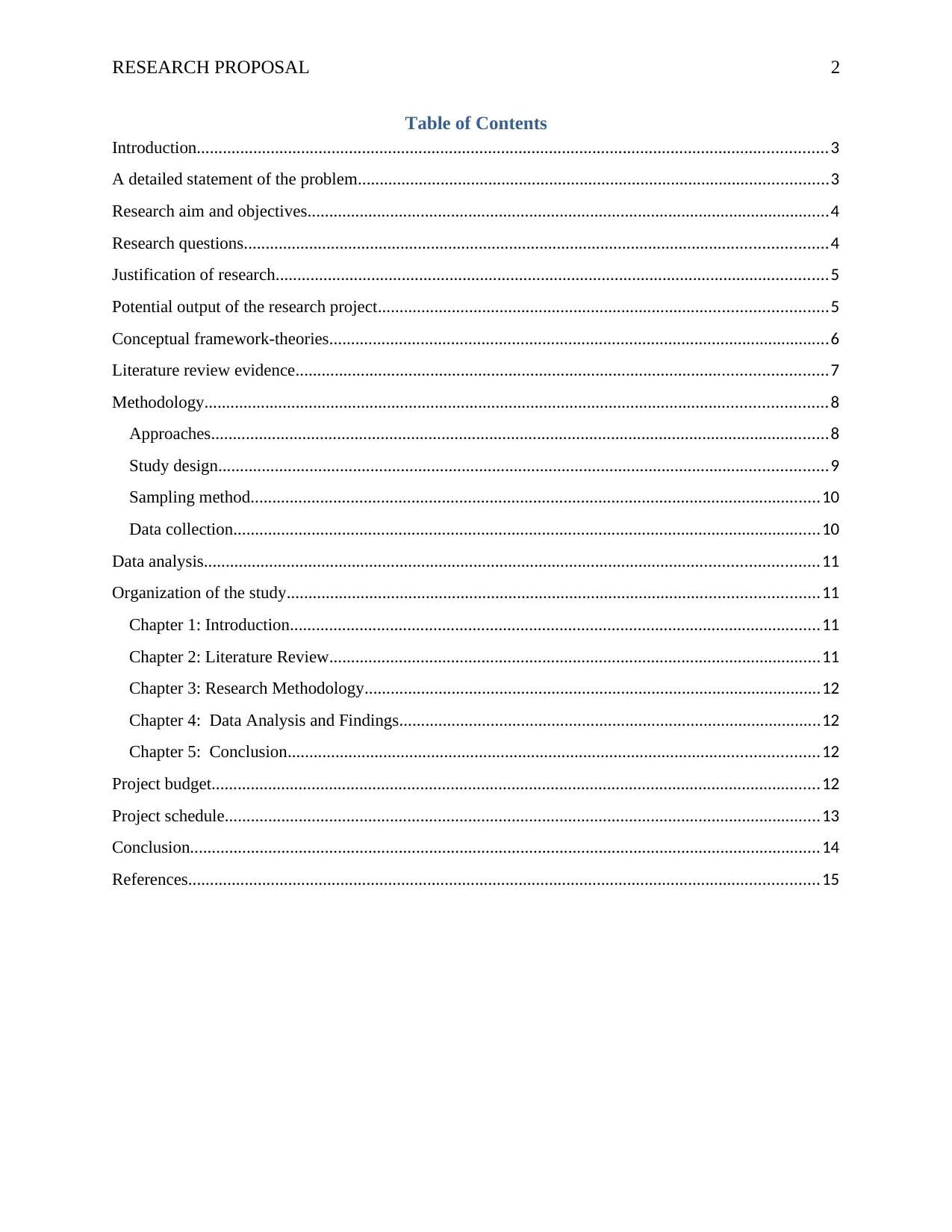
RESEARCH PROPOSAL 2
Table of Contents
Introduction.................................................................................................................................................3
A detailed statement of the problem............................................................................................................3
Research aim and objectives........................................................................................................................4
Research questions......................................................................................................................................4
Justification of research...............................................................................................................................5
Potential output of the research project.......................................................................................................5
Conceptual framework-theories...................................................................................................................6
Literature review evidence..........................................................................................................................7
Methodology...............................................................................................................................................8
Approaches..............................................................................................................................................8
Study design............................................................................................................................................9
Sampling method...................................................................................................................................10
Data collection.......................................................................................................................................10
Data analysis.............................................................................................................................................11
Organization of the study..........................................................................................................................11
Chapter 1: Introduction..........................................................................................................................11
Chapter 2: Literature Review.................................................................................................................11
Chapter 3: Research Methodology.........................................................................................................12
Chapter 4: Data Analysis and Findings.................................................................................................12
Chapter 5: Conclusion..........................................................................................................................12
Project budget............................................................................................................................................12
Project schedule.........................................................................................................................................13
Conclusion.................................................................................................................................................14
References.................................................................................................................................................15
Table of Contents
Introduction.................................................................................................................................................3
A detailed statement of the problem............................................................................................................3
Research aim and objectives........................................................................................................................4
Research questions......................................................................................................................................4
Justification of research...............................................................................................................................5
Potential output of the research project.......................................................................................................5
Conceptual framework-theories...................................................................................................................6
Literature review evidence..........................................................................................................................7
Methodology...............................................................................................................................................8
Approaches..............................................................................................................................................8
Study design............................................................................................................................................9
Sampling method...................................................................................................................................10
Data collection.......................................................................................................................................10
Data analysis.............................................................................................................................................11
Organization of the study..........................................................................................................................11
Chapter 1: Introduction..........................................................................................................................11
Chapter 2: Literature Review.................................................................................................................11
Chapter 3: Research Methodology.........................................................................................................12
Chapter 4: Data Analysis and Findings.................................................................................................12
Chapter 5: Conclusion..........................................................................................................................12
Project budget............................................................................................................................................12
Project schedule.........................................................................................................................................13
Conclusion.................................................................................................................................................14
References.................................................................................................................................................15
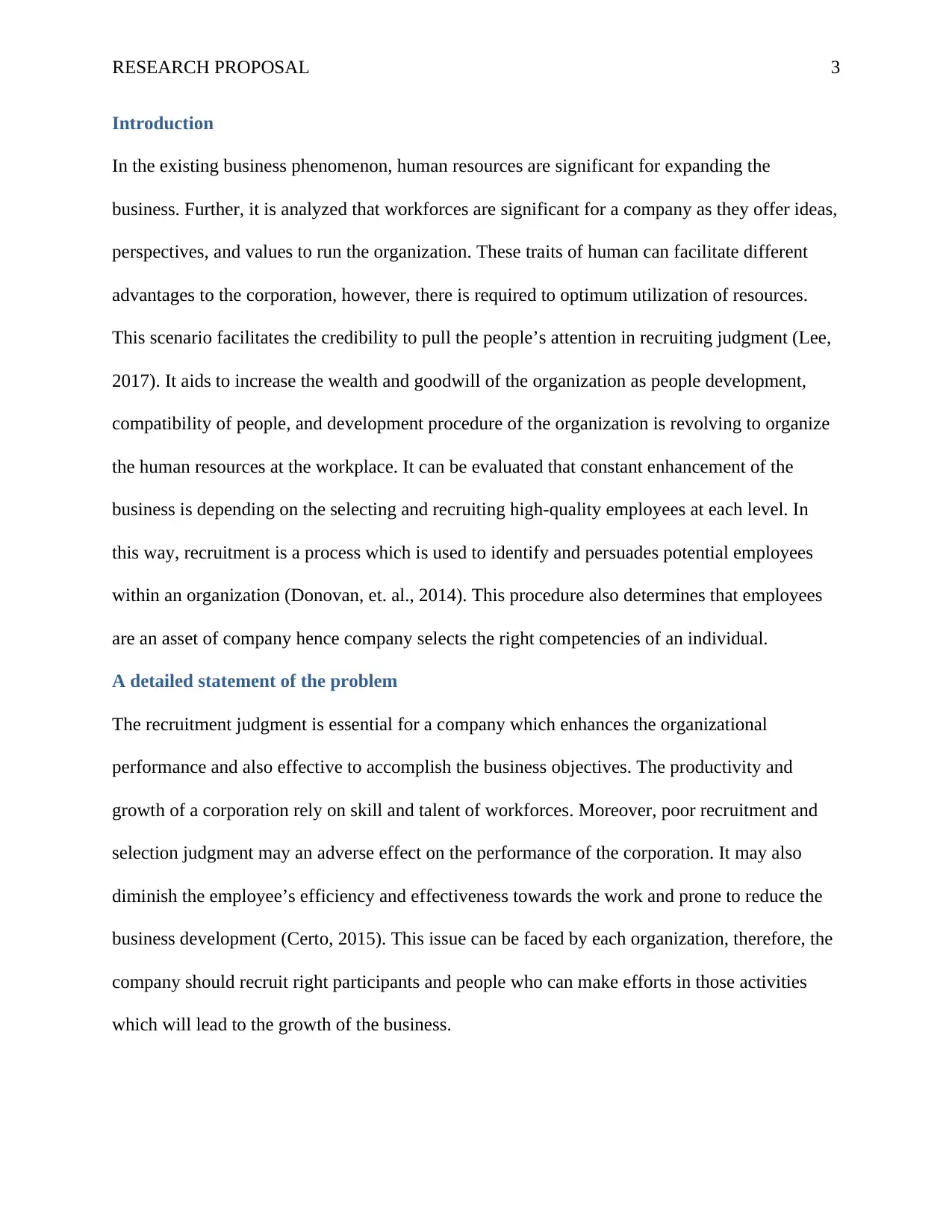
RESEARCH PROPOSAL 3
Introduction
In the existing business phenomenon, human resources are significant for expanding the
business. Further, it is analyzed that workforces are significant for a company as they offer ideas,
perspectives, and values to run the organization. These traits of human can facilitate different
advantages to the corporation, however, there is required to optimum utilization of resources.
This scenario facilitates the credibility to pull the people’s attention in recruiting judgment (Lee,
2017). It aids to increase the wealth and goodwill of the organization as people development,
compatibility of people, and development procedure of the organization is revolving to organize
the human resources at the workplace. It can be evaluated that constant enhancement of the
business is depending on the selecting and recruiting high-quality employees at each level. In
this way, recruitment is a process which is used to identify and persuades potential employees
within an organization (Donovan, et. al., 2014). This procedure also determines that employees
are an asset of company hence company selects the right competencies of an individual.
A detailed statement of the problem
The recruitment judgment is essential for a company which enhances the organizational
performance and also effective to accomplish the business objectives. The productivity and
growth of a corporation rely on skill and talent of workforces. Moreover, poor recruitment and
selection judgment may an adverse effect on the performance of the corporation. It may also
diminish the employee’s efficiency and effectiveness towards the work and prone to reduce the
business development (Certo, 2015). This issue can be faced by each organization, therefore, the
company should recruit right participants and people who can make efforts in those activities
which will lead to the growth of the business.
Introduction
In the existing business phenomenon, human resources are significant for expanding the
business. Further, it is analyzed that workforces are significant for a company as they offer ideas,
perspectives, and values to run the organization. These traits of human can facilitate different
advantages to the corporation, however, there is required to optimum utilization of resources.
This scenario facilitates the credibility to pull the people’s attention in recruiting judgment (Lee,
2017). It aids to increase the wealth and goodwill of the organization as people development,
compatibility of people, and development procedure of the organization is revolving to organize
the human resources at the workplace. It can be evaluated that constant enhancement of the
business is depending on the selecting and recruiting high-quality employees at each level. In
this way, recruitment is a process which is used to identify and persuades potential employees
within an organization (Donovan, et. al., 2014). This procedure also determines that employees
are an asset of company hence company selects the right competencies of an individual.
A detailed statement of the problem
The recruitment judgment is essential for a company which enhances the organizational
performance and also effective to accomplish the business objectives. The productivity and
growth of a corporation rely on skill and talent of workforces. Moreover, poor recruitment and
selection judgment may an adverse effect on the performance of the corporation. It may also
diminish the employee’s efficiency and effectiveness towards the work and prone to reduce the
business development (Certo, 2015). This issue can be faced by each organization, therefore, the
company should recruit right participants and people who can make efforts in those activities
which will lead to the growth of the business.
⊘ This is a preview!⊘
Do you want full access?
Subscribe today to unlock all pages.

Trusted by 1+ million students worldwide
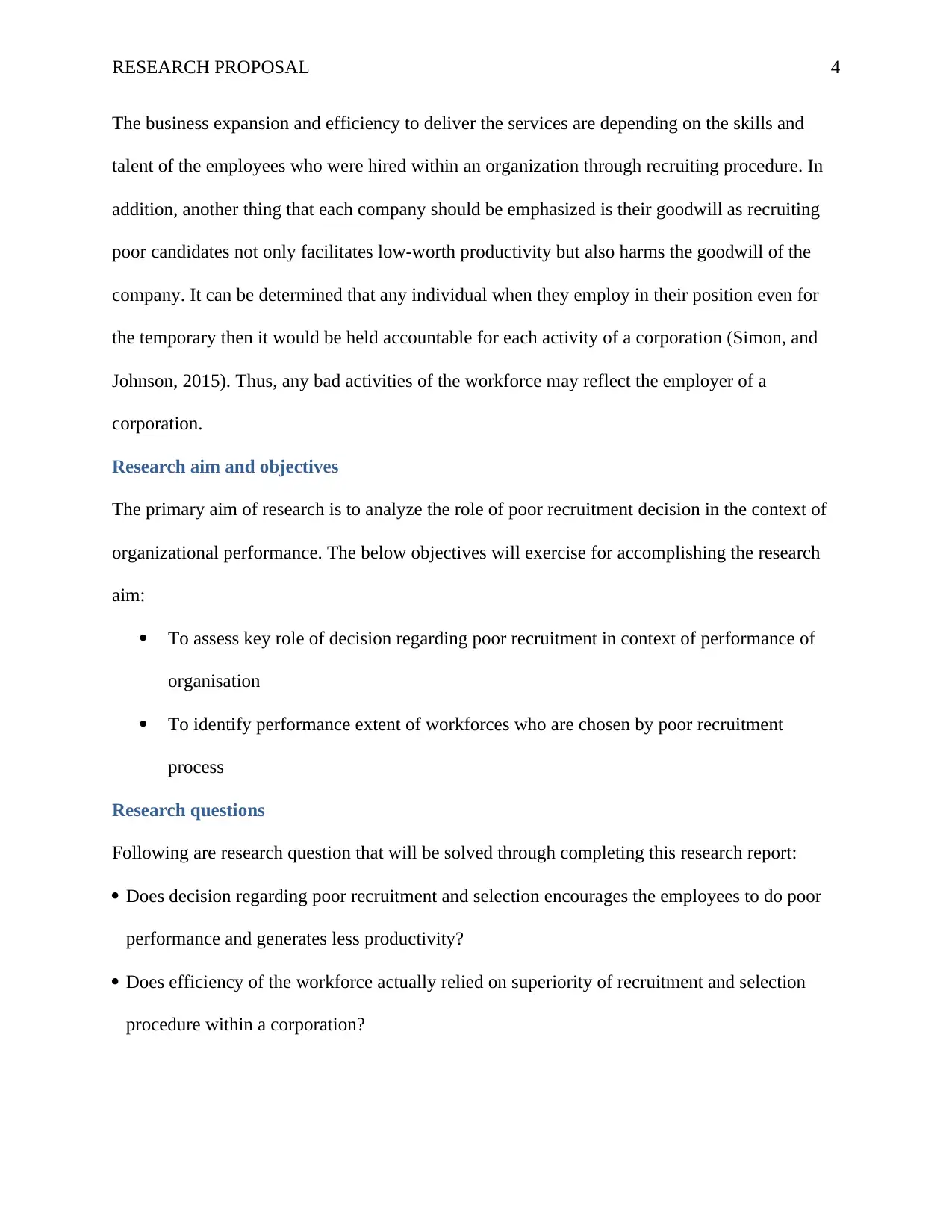
RESEARCH PROPOSAL 4
The business expansion and efficiency to deliver the services are depending on the skills and
talent of the employees who were hired within an organization through recruiting procedure. In
addition, another thing that each company should be emphasized is their goodwill as recruiting
poor candidates not only facilitates low-worth productivity but also harms the goodwill of the
company. It can be determined that any individual when they employ in their position even for
the temporary then it would be held accountable for each activity of a corporation (Simon, and
Johnson, 2015). Thus, any bad activities of the workforce may reflect the employer of a
corporation.
Research aim and objectives
The primary aim of research is to analyze the role of poor recruitment decision in the context of
organizational performance. The below objectives will exercise for accomplishing the research
aim:
To assess key role of decision regarding poor recruitment in context of performance of
organisation
To identify performance extent of workforces who are chosen by poor recruitment
process
Research questions
Following are research question that will be solved through completing this research report:
Does decision regarding poor recruitment and selection encourages the employees to do poor
performance and generates less productivity?
Does efficiency of the workforce actually relied on superiority of recruitment and selection
procedure within a corporation?
The business expansion and efficiency to deliver the services are depending on the skills and
talent of the employees who were hired within an organization through recruiting procedure. In
addition, another thing that each company should be emphasized is their goodwill as recruiting
poor candidates not only facilitates low-worth productivity but also harms the goodwill of the
company. It can be determined that any individual when they employ in their position even for
the temporary then it would be held accountable for each activity of a corporation (Simon, and
Johnson, 2015). Thus, any bad activities of the workforce may reflect the employer of a
corporation.
Research aim and objectives
The primary aim of research is to analyze the role of poor recruitment decision in the context of
organizational performance. The below objectives will exercise for accomplishing the research
aim:
To assess key role of decision regarding poor recruitment in context of performance of
organisation
To identify performance extent of workforces who are chosen by poor recruitment
process
Research questions
Following are research question that will be solved through completing this research report:
Does decision regarding poor recruitment and selection encourages the employees to do poor
performance and generates less productivity?
Does efficiency of the workforce actually relied on superiority of recruitment and selection
procedure within a corporation?
Paraphrase This Document
Need a fresh take? Get an instant paraphrase of this document with our AI Paraphraser
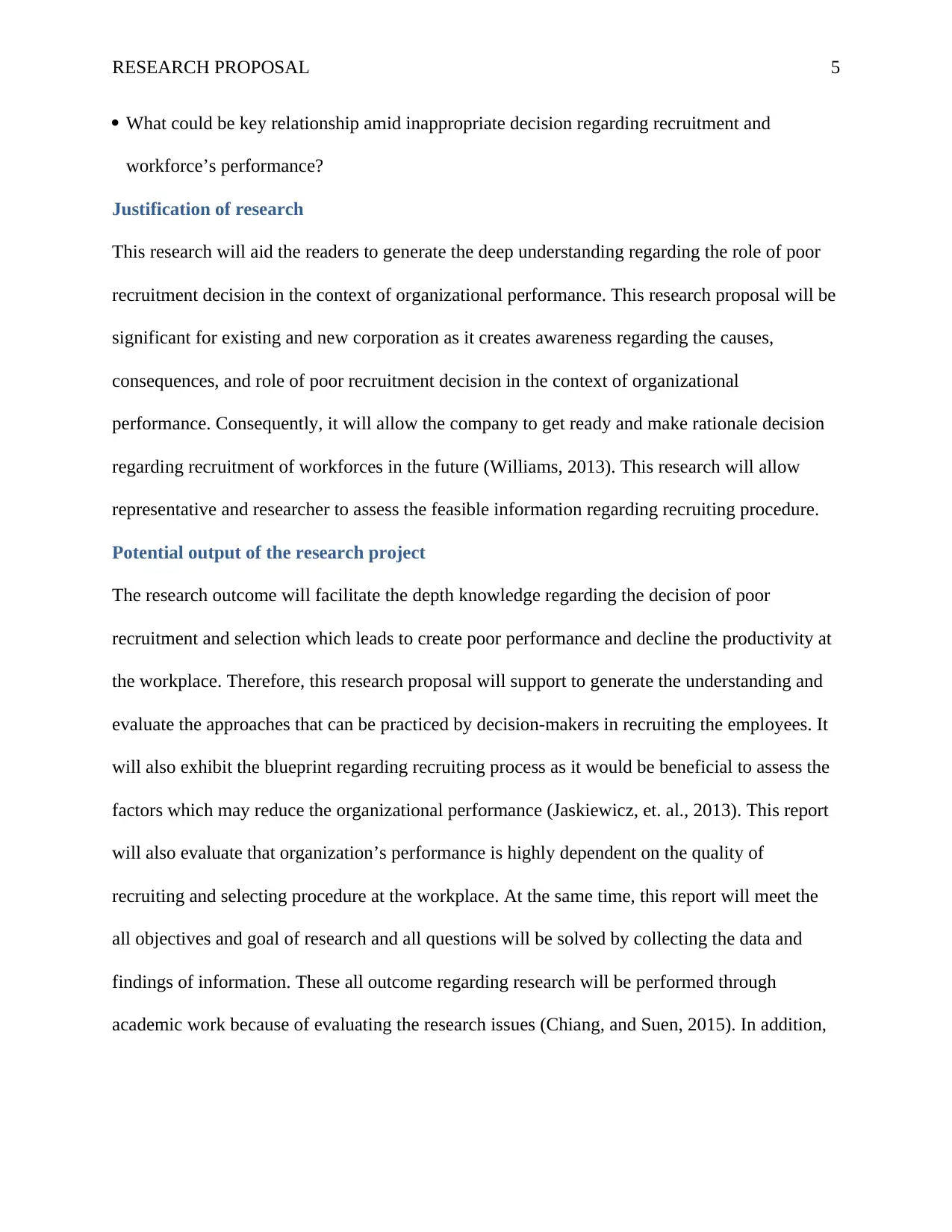
RESEARCH PROPOSAL 5
What could be key relationship amid inappropriate decision regarding recruitment and
workforce’s performance?
Justification of research
This research will aid the readers to generate the deep understanding regarding the role of poor
recruitment decision in the context of organizational performance. This research proposal will be
significant for existing and new corporation as it creates awareness regarding the causes,
consequences, and role of poor recruitment decision in the context of organizational
performance. Consequently, it will allow the company to get ready and make rationale decision
regarding recruitment of workforces in the future (Williams, 2013). This research will allow
representative and researcher to assess the feasible information regarding recruiting procedure.
Potential output of the research project
The research outcome will facilitate the depth knowledge regarding the decision of poor
recruitment and selection which leads to create poor performance and decline the productivity at
the workplace. Therefore, this research proposal will support to generate the understanding and
evaluate the approaches that can be practiced by decision-makers in recruiting the employees. It
will also exhibit the blueprint regarding recruiting process as it would be beneficial to assess the
factors which may reduce the organizational performance (Jaskiewicz, et. al., 2013). This report
will also evaluate that organization’s performance is highly dependent on the quality of
recruiting and selecting procedure at the workplace. At the same time, this report will meet the
all objectives and goal of research and all questions will be solved by collecting the data and
findings of information. These all outcome regarding research will be performed through
academic work because of evaluating the research issues (Chiang, and Suen, 2015). In addition,
What could be key relationship amid inappropriate decision regarding recruitment and
workforce’s performance?
Justification of research
This research will aid the readers to generate the deep understanding regarding the role of poor
recruitment decision in the context of organizational performance. This research proposal will be
significant for existing and new corporation as it creates awareness regarding the causes,
consequences, and role of poor recruitment decision in the context of organizational
performance. Consequently, it will allow the company to get ready and make rationale decision
regarding recruitment of workforces in the future (Williams, 2013). This research will allow
representative and researcher to assess the feasible information regarding recruiting procedure.
Potential output of the research project
The research outcome will facilitate the depth knowledge regarding the decision of poor
recruitment and selection which leads to create poor performance and decline the productivity at
the workplace. Therefore, this research proposal will support to generate the understanding and
evaluate the approaches that can be practiced by decision-makers in recruiting the employees. It
will also exhibit the blueprint regarding recruiting process as it would be beneficial to assess the
factors which may reduce the organizational performance (Jaskiewicz, et. al., 2013). This report
will also evaluate that organization’s performance is highly dependent on the quality of
recruiting and selecting procedure at the workplace. At the same time, this report will meet the
all objectives and goal of research and all questions will be solved by collecting the data and
findings of information. These all outcome regarding research will be performed through
academic work because of evaluating the research issues (Chiang, and Suen, 2015). In addition,
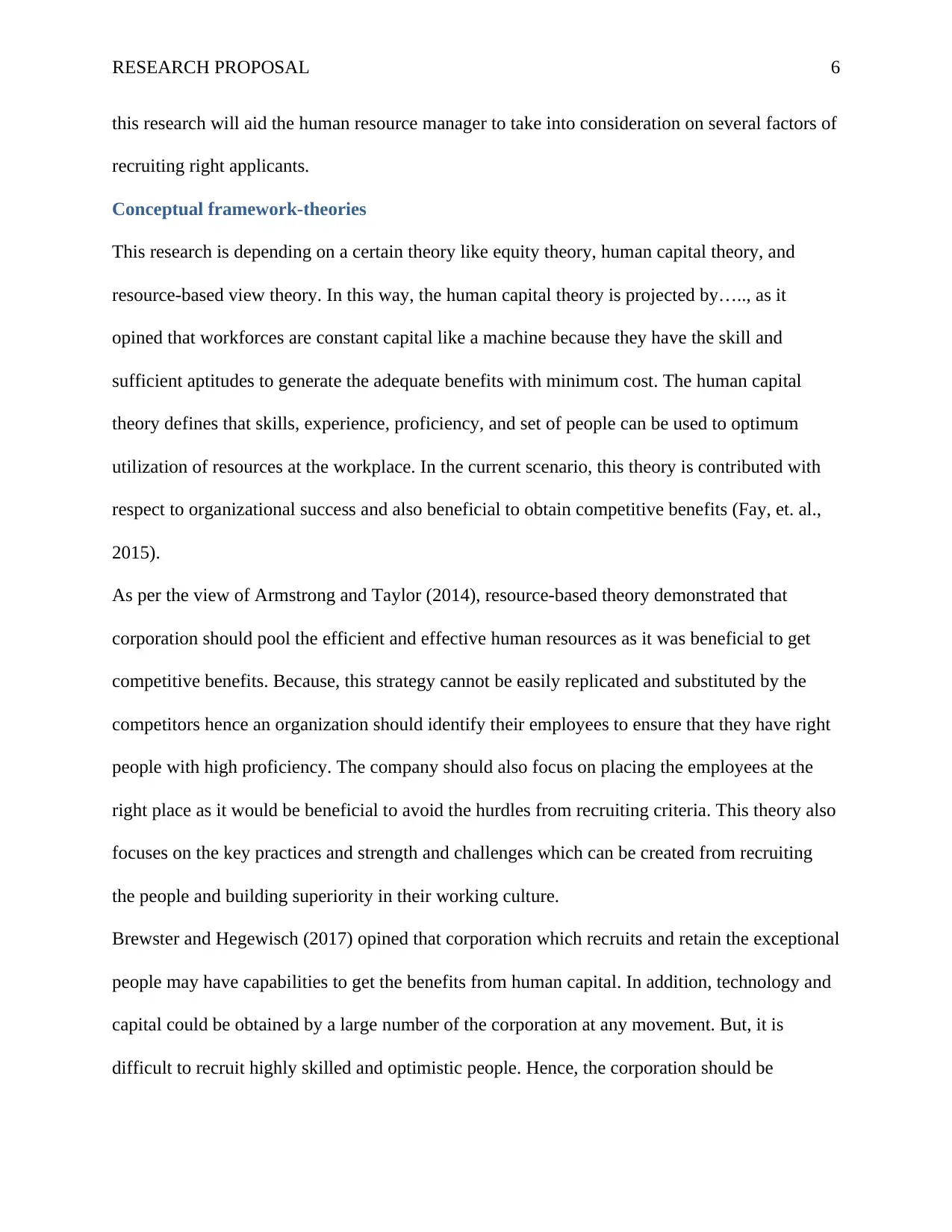
RESEARCH PROPOSAL 6
this research will aid the human resource manager to take into consideration on several factors of
recruiting right applicants.
Conceptual framework-theories
This research is depending on a certain theory like equity theory, human capital theory, and
resource-based view theory. In this way, the human capital theory is projected by….., as it
opined that workforces are constant capital like a machine because they have the skill and
sufficient aptitudes to generate the adequate benefits with minimum cost. The human capital
theory defines that skills, experience, proficiency, and set of people can be used to optimum
utilization of resources at the workplace. In the current scenario, this theory is contributed with
respect to organizational success and also beneficial to obtain competitive benefits (Fay, et. al.,
2015).
As per the view of Armstrong and Taylor (2014), resource-based theory demonstrated that
corporation should pool the efficient and effective human resources as it was beneficial to get
competitive benefits. Because, this strategy cannot be easily replicated and substituted by the
competitors hence an organization should identify their employees to ensure that they have right
people with high proficiency. The company should also focus on placing the employees at the
right place as it would be beneficial to avoid the hurdles from recruiting criteria. This theory also
focuses on the key practices and strength and challenges which can be created from recruiting
the people and building superiority in their working culture.
Brewster and Hegewisch (2017) opined that corporation which recruits and retain the exceptional
people may have capabilities to get the benefits from human capital. In addition, technology and
capital could be obtained by a large number of the corporation at any movement. But, it is
difficult to recruit highly skilled and optimistic people. Hence, the corporation should be
this research will aid the human resource manager to take into consideration on several factors of
recruiting right applicants.
Conceptual framework-theories
This research is depending on a certain theory like equity theory, human capital theory, and
resource-based view theory. In this way, the human capital theory is projected by….., as it
opined that workforces are constant capital like a machine because they have the skill and
sufficient aptitudes to generate the adequate benefits with minimum cost. The human capital
theory defines that skills, experience, proficiency, and set of people can be used to optimum
utilization of resources at the workplace. In the current scenario, this theory is contributed with
respect to organizational success and also beneficial to obtain competitive benefits (Fay, et. al.,
2015).
As per the view of Armstrong and Taylor (2014), resource-based theory demonstrated that
corporation should pool the efficient and effective human resources as it was beneficial to get
competitive benefits. Because, this strategy cannot be easily replicated and substituted by the
competitors hence an organization should identify their employees to ensure that they have right
people with high proficiency. The company should also focus on placing the employees at the
right place as it would be beneficial to avoid the hurdles from recruiting criteria. This theory also
focuses on the key practices and strength and challenges which can be created from recruiting
the people and building superiority in their working culture.
Brewster and Hegewisch (2017) opined that corporation which recruits and retain the exceptional
people may have capabilities to get the benefits from human capital. In addition, technology and
capital could be obtained by a large number of the corporation at any movement. But, it is
difficult to recruit highly skilled and optimistic people. Hence, the corporation should be
⊘ This is a preview!⊘
Do you want full access?
Subscribe today to unlock all pages.

Trusted by 1+ million students worldwide
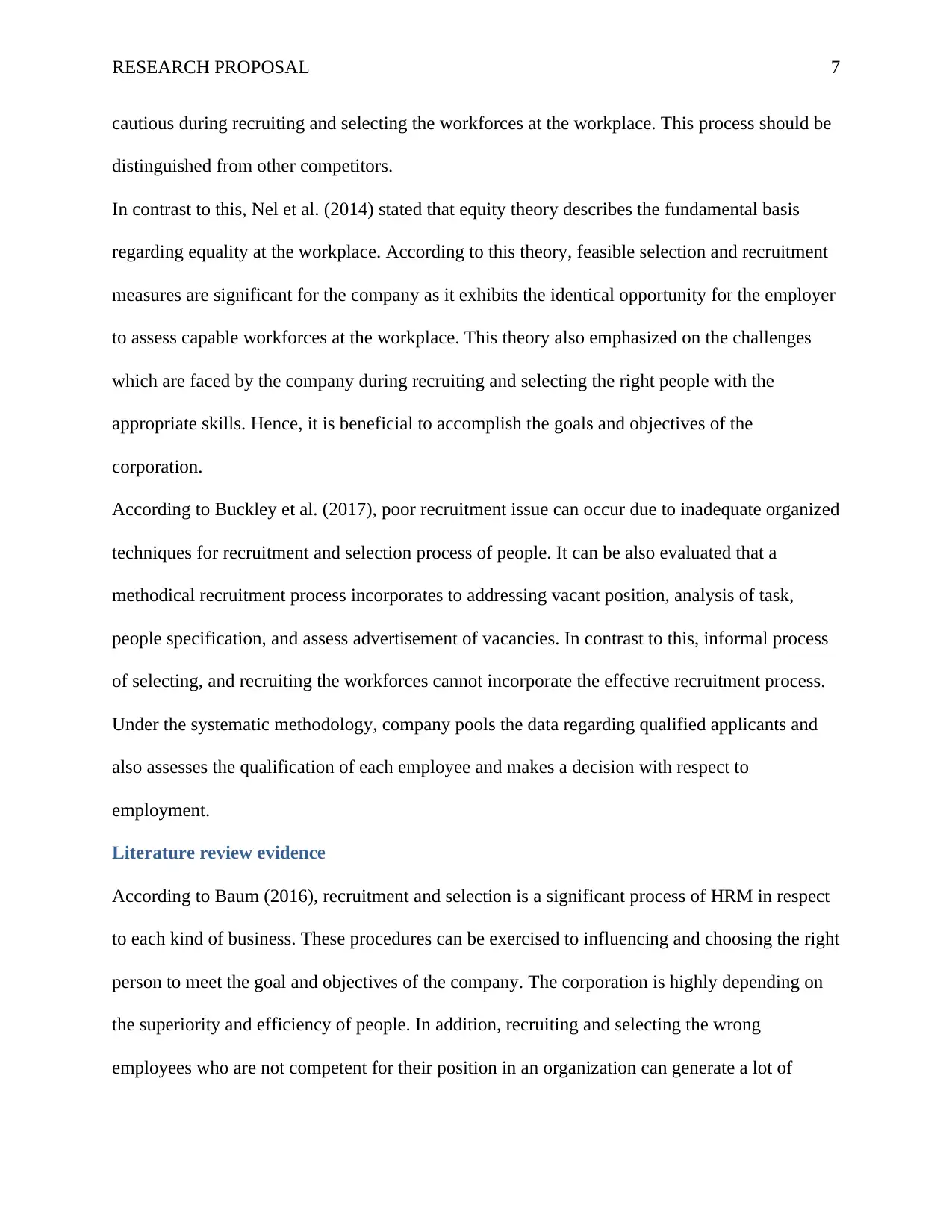
RESEARCH PROPOSAL 7
cautious during recruiting and selecting the workforces at the workplace. This process should be
distinguished from other competitors.
In contrast to this, Nel et al. (2014) stated that equity theory describes the fundamental basis
regarding equality at the workplace. According to this theory, feasible selection and recruitment
measures are significant for the company as it exhibits the identical opportunity for the employer
to assess capable workforces at the workplace. This theory also emphasized on the challenges
which are faced by the company during recruiting and selecting the right people with the
appropriate skills. Hence, it is beneficial to accomplish the goals and objectives of the
corporation.
According to Buckley et al. (2017), poor recruitment issue can occur due to inadequate organized
techniques for recruitment and selection process of people. It can be also evaluated that a
methodical recruitment process incorporates to addressing vacant position, analysis of task,
people specification, and assess advertisement of vacancies. In contrast to this, informal process
of selecting, and recruiting the workforces cannot incorporate the effective recruitment process.
Under the systematic methodology, company pools the data regarding qualified applicants and
also assesses the qualification of each employee and makes a decision with respect to
employment.
Literature review evidence
According to Baum (2016), recruitment and selection is a significant process of HRM in respect
to each kind of business. These procedures can be exercised to influencing and choosing the right
person to meet the goal and objectives of the company. The corporation is highly depending on
the superiority and efficiency of people. In addition, recruiting and selecting the wrong
employees who are not competent for their position in an organization can generate a lot of
cautious during recruiting and selecting the workforces at the workplace. This process should be
distinguished from other competitors.
In contrast to this, Nel et al. (2014) stated that equity theory describes the fundamental basis
regarding equality at the workplace. According to this theory, feasible selection and recruitment
measures are significant for the company as it exhibits the identical opportunity for the employer
to assess capable workforces at the workplace. This theory also emphasized on the challenges
which are faced by the company during recruiting and selecting the right people with the
appropriate skills. Hence, it is beneficial to accomplish the goals and objectives of the
corporation.
According to Buckley et al. (2017), poor recruitment issue can occur due to inadequate organized
techniques for recruitment and selection process of people. It can be also evaluated that a
methodical recruitment process incorporates to addressing vacant position, analysis of task,
people specification, and assess advertisement of vacancies. In contrast to this, informal process
of selecting, and recruiting the workforces cannot incorporate the effective recruitment process.
Under the systematic methodology, company pools the data regarding qualified applicants and
also assesses the qualification of each employee and makes a decision with respect to
employment.
Literature review evidence
According to Baum (2016), recruitment and selection is a significant process of HRM in respect
to each kind of business. These procedures can be exercised to influencing and choosing the right
person to meet the goal and objectives of the company. The corporation is highly depending on
the superiority and efficiency of people. In addition, recruiting and selecting the wrong
employees who are not competent for their position in an organization can generate a lot of
Paraphrase This Document
Need a fresh take? Get an instant paraphrase of this document with our AI Paraphraser
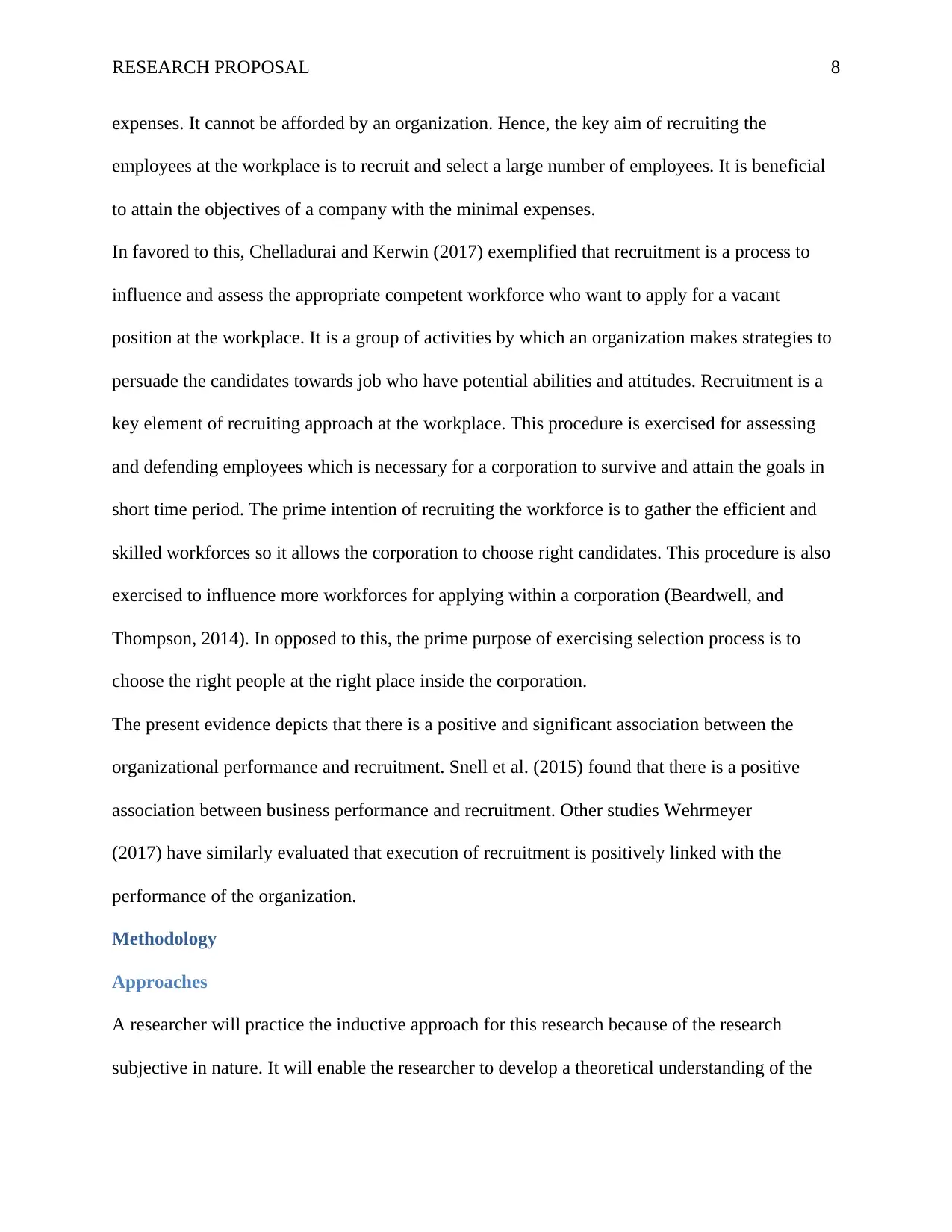
RESEARCH PROPOSAL 8
expenses. It cannot be afforded by an organization. Hence, the key aim of recruiting the
employees at the workplace is to recruit and select a large number of employees. It is beneficial
to attain the objectives of a company with the minimal expenses.
In favored to this, Chelladurai and Kerwin (2017) exemplified that recruitment is a process to
influence and assess the appropriate competent workforce who want to apply for a vacant
position at the workplace. It is a group of activities by which an organization makes strategies to
persuade the candidates towards job who have potential abilities and attitudes. Recruitment is a
key element of recruiting approach at the workplace. This procedure is exercised for assessing
and defending employees which is necessary for a corporation to survive and attain the goals in
short time period. The prime intention of recruiting the workforce is to gather the efficient and
skilled workforces so it allows the corporation to choose right candidates. This procedure is also
exercised to influence more workforces for applying within a corporation (Beardwell, and
Thompson, 2014). In opposed to this, the prime purpose of exercising selection process is to
choose the right people at the right place inside the corporation.
The present evidence depicts that there is a positive and significant association between the
organizational performance and recruitment. Snell et al. (2015) found that there is a positive
association between business performance and recruitment. Other studies Wehrmeyer
(2017) have similarly evaluated that execution of recruitment is positively linked with the
performance of the organization.
Methodology
Approaches
A researcher will practice the inductive approach for this research because of the research
subjective in nature. It will enable the researcher to develop a theoretical understanding of the
expenses. It cannot be afforded by an organization. Hence, the key aim of recruiting the
employees at the workplace is to recruit and select a large number of employees. It is beneficial
to attain the objectives of a company with the minimal expenses.
In favored to this, Chelladurai and Kerwin (2017) exemplified that recruitment is a process to
influence and assess the appropriate competent workforce who want to apply for a vacant
position at the workplace. It is a group of activities by which an organization makes strategies to
persuade the candidates towards job who have potential abilities and attitudes. Recruitment is a
key element of recruiting approach at the workplace. This procedure is exercised for assessing
and defending employees which is necessary for a corporation to survive and attain the goals in
short time period. The prime intention of recruiting the workforce is to gather the efficient and
skilled workforces so it allows the corporation to choose right candidates. This procedure is also
exercised to influence more workforces for applying within a corporation (Beardwell, and
Thompson, 2014). In opposed to this, the prime purpose of exercising selection process is to
choose the right people at the right place inside the corporation.
The present evidence depicts that there is a positive and significant association between the
organizational performance and recruitment. Snell et al. (2015) found that there is a positive
association between business performance and recruitment. Other studies Wehrmeyer
(2017) have similarly evaluated that execution of recruitment is positively linked with the
performance of the organization.
Methodology
Approaches
A researcher will practice the inductive approach for this research because of the research
subjective in nature. It will enable the researcher to develop a theoretical understanding of the
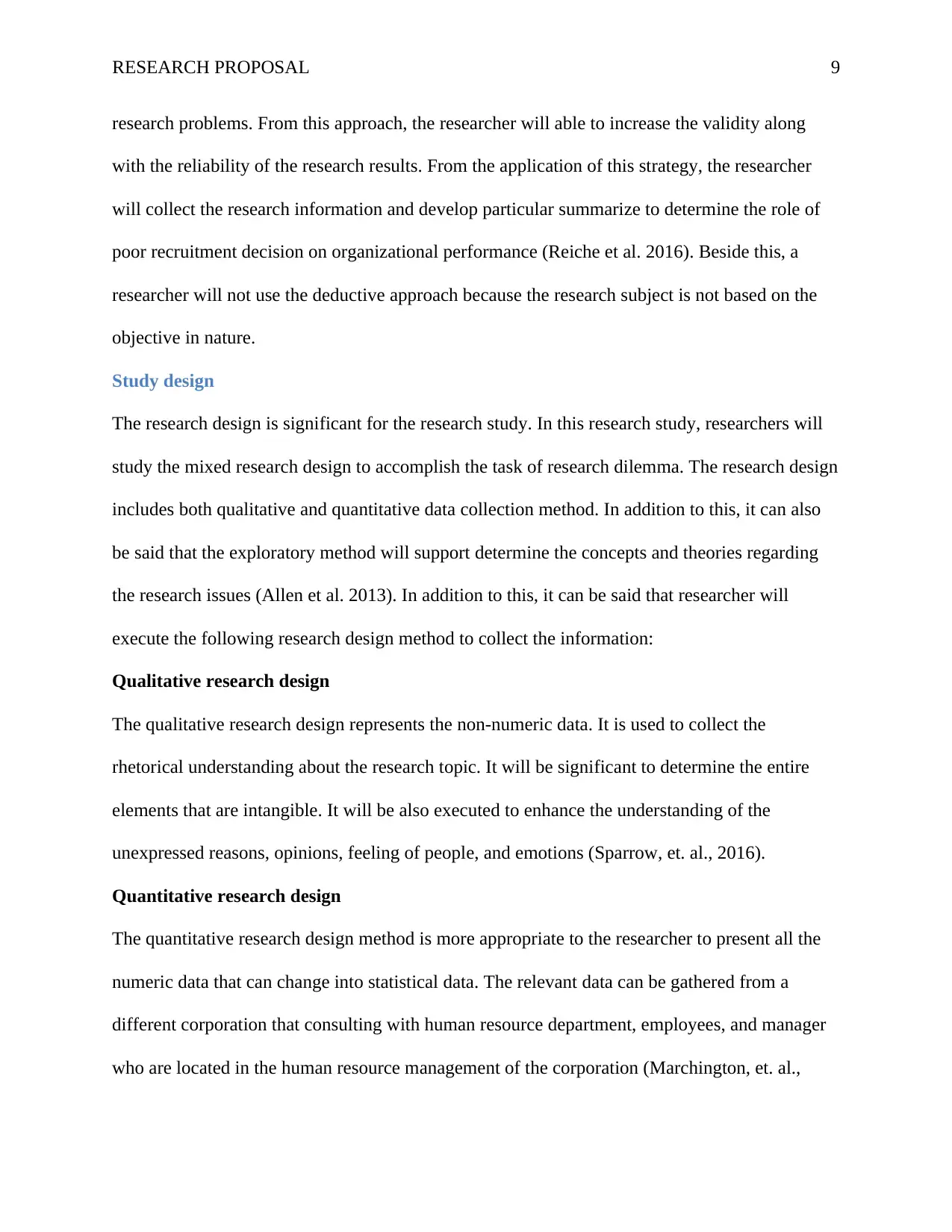
RESEARCH PROPOSAL 9
research problems. From this approach, the researcher will able to increase the validity along
with the reliability of the research results. From the application of this strategy, the researcher
will collect the research information and develop particular summarize to determine the role of
poor recruitment decision on organizational performance (Reiche et al. 2016). Beside this, a
researcher will not use the deductive approach because the research subject is not based on the
objective in nature.
Study design
The research design is significant for the research study. In this research study, researchers will
study the mixed research design to accomplish the task of research dilemma. The research design
includes both qualitative and quantitative data collection method. In addition to this, it can also
be said that the exploratory method will support determine the concepts and theories regarding
the research issues (Allen et al. 2013). In addition to this, it can be said that researcher will
execute the following research design method to collect the information:
Qualitative research design
The qualitative research design represents the non-numeric data. It is used to collect the
rhetorical understanding about the research topic. It will be significant to determine the entire
elements that are intangible. It will be also executed to enhance the understanding of the
unexpressed reasons, opinions, feeling of people, and emotions (Sparrow, et. al., 2016).
Quantitative research design
The quantitative research design method is more appropriate to the researcher to present all the
numeric data that can change into statistical data. The relevant data can be gathered from a
different corporation that consulting with human resource department, employees, and manager
who are located in the human resource management of the corporation (Marchington, et. al.,
research problems. From this approach, the researcher will able to increase the validity along
with the reliability of the research results. From the application of this strategy, the researcher
will collect the research information and develop particular summarize to determine the role of
poor recruitment decision on organizational performance (Reiche et al. 2016). Beside this, a
researcher will not use the deductive approach because the research subject is not based on the
objective in nature.
Study design
The research design is significant for the research study. In this research study, researchers will
study the mixed research design to accomplish the task of research dilemma. The research design
includes both qualitative and quantitative data collection method. In addition to this, it can also
be said that the exploratory method will support determine the concepts and theories regarding
the research issues (Allen et al. 2013). In addition to this, it can be said that researcher will
execute the following research design method to collect the information:
Qualitative research design
The qualitative research design represents the non-numeric data. It is used to collect the
rhetorical understanding about the research topic. It will be significant to determine the entire
elements that are intangible. It will be also executed to enhance the understanding of the
unexpressed reasons, opinions, feeling of people, and emotions (Sparrow, et. al., 2016).
Quantitative research design
The quantitative research design method is more appropriate to the researcher to present all the
numeric data that can change into statistical data. The relevant data can be gathered from a
different corporation that consulting with human resource department, employees, and manager
who are located in the human resource management of the corporation (Marchington, et. al.,
⊘ This is a preview!⊘
Do you want full access?
Subscribe today to unlock all pages.

Trusted by 1+ million students worldwide
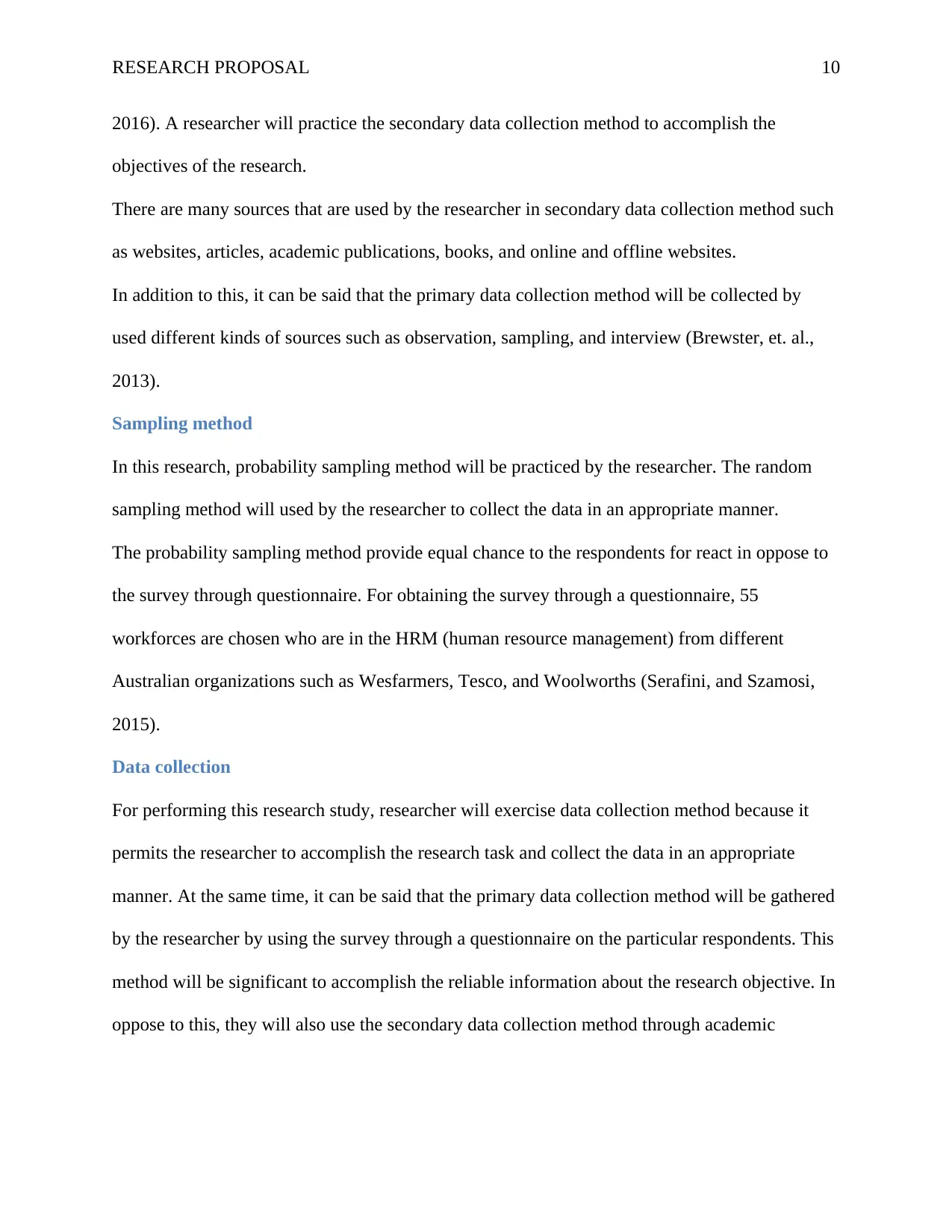
RESEARCH PROPOSAL 10
2016). A researcher will practice the secondary data collection method to accomplish the
objectives of the research.
There are many sources that are used by the researcher in secondary data collection method such
as websites, articles, academic publications, books, and online and offline websites.
In addition to this, it can be said that the primary data collection method will be collected by
used different kinds of sources such as observation, sampling, and interview (Brewster, et. al.,
2013).
Sampling method
In this research, probability sampling method will be practiced by the researcher. The random
sampling method will used by the researcher to collect the data in an appropriate manner.
The probability sampling method provide equal chance to the respondents for react in oppose to
the survey through questionnaire. For obtaining the survey through a questionnaire, 55
workforces are chosen who are in the HRM (human resource management) from different
Australian organizations such as Wesfarmers, Tesco, and Woolworths (Serafini, and Szamosi,
2015).
Data collection
For performing this research study, researcher will exercise data collection method because it
permits the researcher to accomplish the research task and collect the data in an appropriate
manner. At the same time, it can be said that the primary data collection method will be gathered
by the researcher by using the survey through a questionnaire on the particular respondents. This
method will be significant to accomplish the reliable information about the research objective. In
oppose to this, they will also use the secondary data collection method through academic
2016). A researcher will practice the secondary data collection method to accomplish the
objectives of the research.
There are many sources that are used by the researcher in secondary data collection method such
as websites, articles, academic publications, books, and online and offline websites.
In addition to this, it can be said that the primary data collection method will be collected by
used different kinds of sources such as observation, sampling, and interview (Brewster, et. al.,
2013).
Sampling method
In this research, probability sampling method will be practiced by the researcher. The random
sampling method will used by the researcher to collect the data in an appropriate manner.
The probability sampling method provide equal chance to the respondents for react in oppose to
the survey through questionnaire. For obtaining the survey through a questionnaire, 55
workforces are chosen who are in the HRM (human resource management) from different
Australian organizations such as Wesfarmers, Tesco, and Woolworths (Serafini, and Szamosi,
2015).
Data collection
For performing this research study, researcher will exercise data collection method because it
permits the researcher to accomplish the research task and collect the data in an appropriate
manner. At the same time, it can be said that the primary data collection method will be gathered
by the researcher by using the survey through a questionnaire on the particular respondents. This
method will be significant to accomplish the reliable information about the research objective. In
oppose to this, they will also use the secondary data collection method through academic
Paraphrase This Document
Need a fresh take? Get an instant paraphrase of this document with our AI Paraphraser
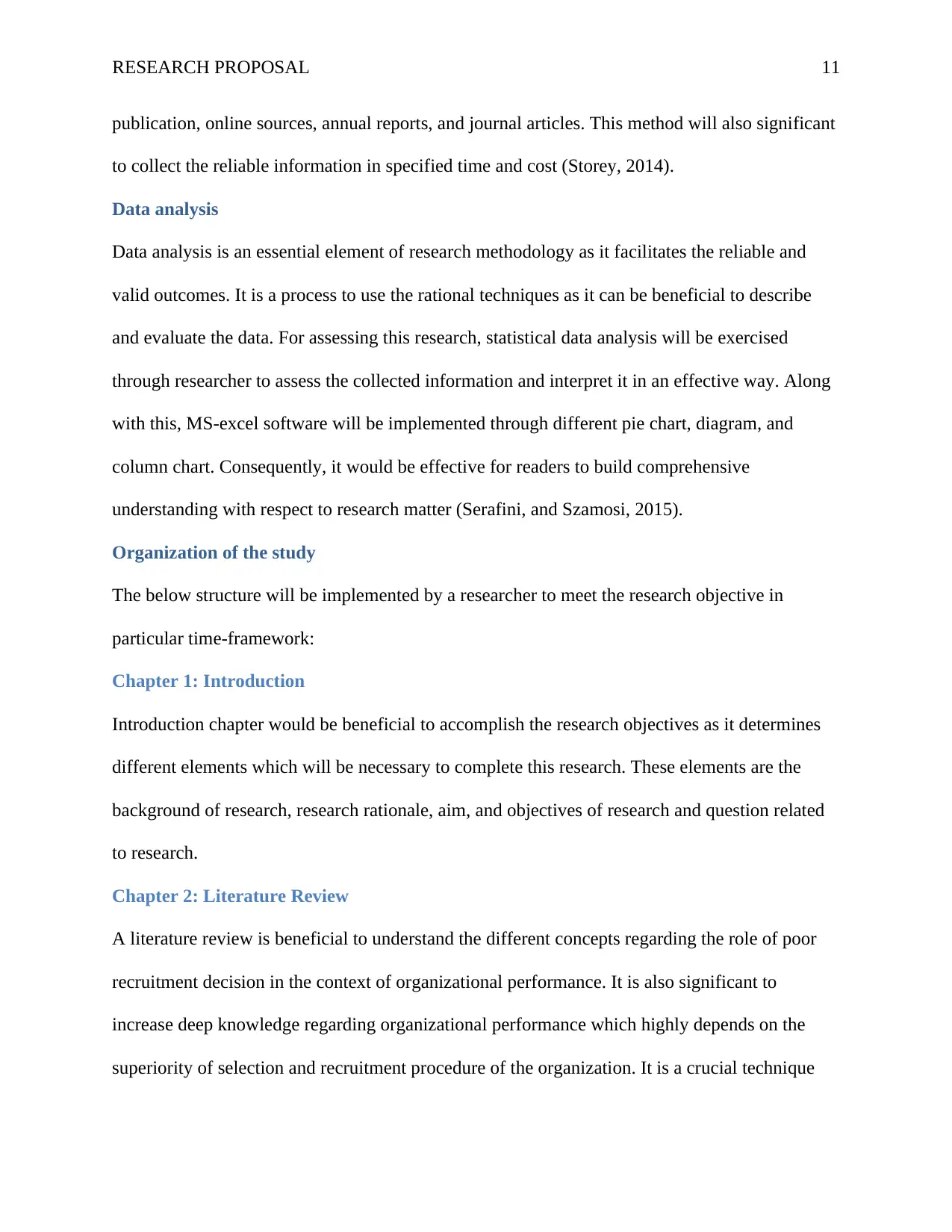
RESEARCH PROPOSAL 11
publication, online sources, annual reports, and journal articles. This method will also significant
to collect the reliable information in specified time and cost (Storey, 2014).
Data analysis
Data analysis is an essential element of research methodology as it facilitates the reliable and
valid outcomes. It is a process to use the rational techniques as it can be beneficial to describe
and evaluate the data. For assessing this research, statistical data analysis will be exercised
through researcher to assess the collected information and interpret it in an effective way. Along
with this, MS-excel software will be implemented through different pie chart, diagram, and
column chart. Consequently, it would be effective for readers to build comprehensive
understanding with respect to research matter (Serafini, and Szamosi, 2015).
Organization of the study
The below structure will be implemented by a researcher to meet the research objective in
particular time-framework:
Chapter 1: Introduction
Introduction chapter would be beneficial to accomplish the research objectives as it determines
different elements which will be necessary to complete this research. These elements are the
background of research, research rationale, aim, and objectives of research and question related
to research.
Chapter 2: Literature Review
A literature review is beneficial to understand the different concepts regarding the role of poor
recruitment decision in the context of organizational performance. It is also significant to
increase deep knowledge regarding organizational performance which highly depends on the
superiority of selection and recruitment procedure of the organization. It is a crucial technique
publication, online sources, annual reports, and journal articles. This method will also significant
to collect the reliable information in specified time and cost (Storey, 2014).
Data analysis
Data analysis is an essential element of research methodology as it facilitates the reliable and
valid outcomes. It is a process to use the rational techniques as it can be beneficial to describe
and evaluate the data. For assessing this research, statistical data analysis will be exercised
through researcher to assess the collected information and interpret it in an effective way. Along
with this, MS-excel software will be implemented through different pie chart, diagram, and
column chart. Consequently, it would be effective for readers to build comprehensive
understanding with respect to research matter (Serafini, and Szamosi, 2015).
Organization of the study
The below structure will be implemented by a researcher to meet the research objective in
particular time-framework:
Chapter 1: Introduction
Introduction chapter would be beneficial to accomplish the research objectives as it determines
different elements which will be necessary to complete this research. These elements are the
background of research, research rationale, aim, and objectives of research and question related
to research.
Chapter 2: Literature Review
A literature review is beneficial to understand the different concepts regarding the role of poor
recruitment decision in the context of organizational performance. It is also significant to
increase deep knowledge regarding organizational performance which highly depends on the
superiority of selection and recruitment procedure of the organization. It is a crucial technique
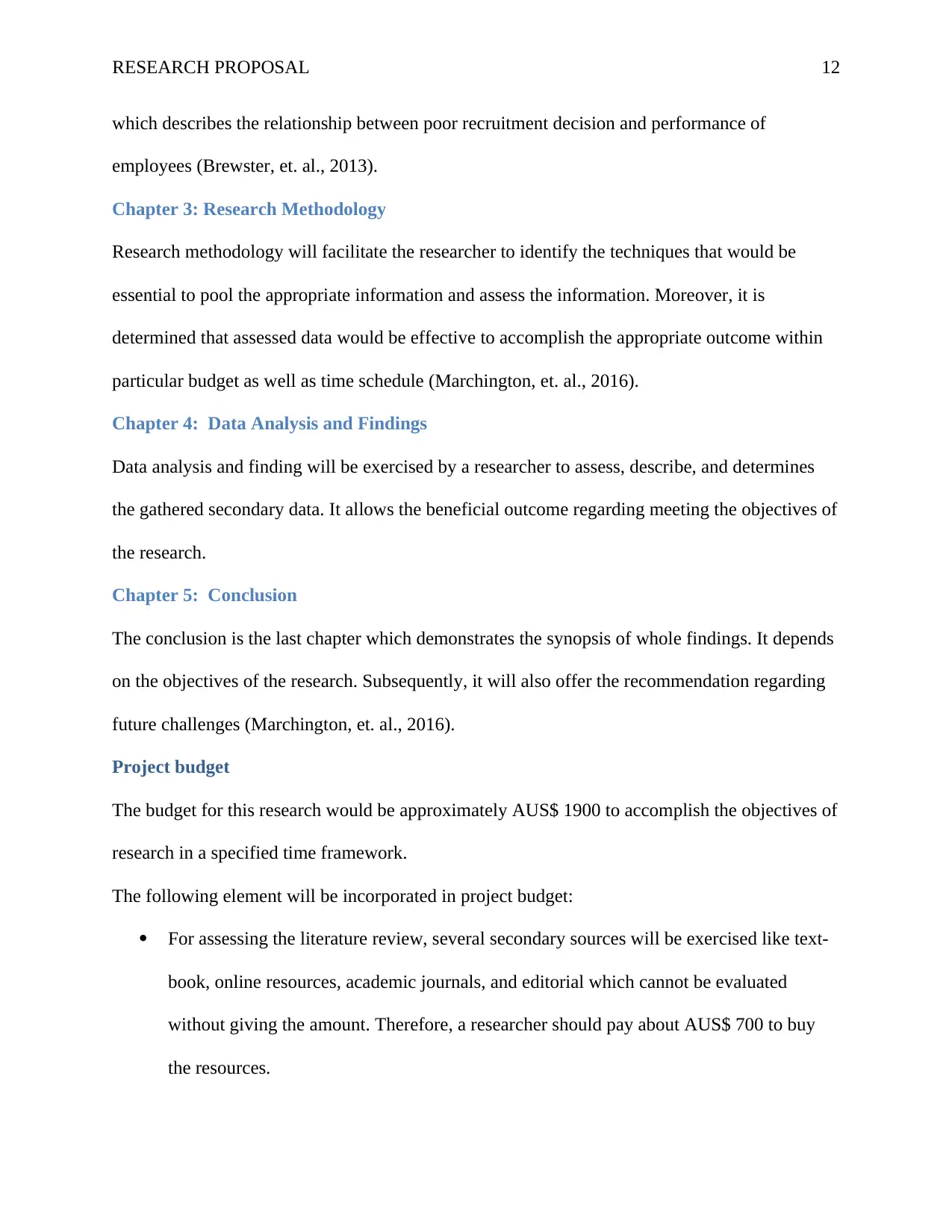
RESEARCH PROPOSAL 12
which describes the relationship between poor recruitment decision and performance of
employees (Brewster, et. al., 2013).
Chapter 3: Research Methodology
Research methodology will facilitate the researcher to identify the techniques that would be
essential to pool the appropriate information and assess the information. Moreover, it is
determined that assessed data would be effective to accomplish the appropriate outcome within
particular budget as well as time schedule (Marchington, et. al., 2016).
Chapter 4: Data Analysis and Findings
Data analysis and finding will be exercised by a researcher to assess, describe, and determines
the gathered secondary data. It allows the beneficial outcome regarding meeting the objectives of
the research.
Chapter 5: Conclusion
The conclusion is the last chapter which demonstrates the synopsis of whole findings. It depends
on the objectives of the research. Subsequently, it will also offer the recommendation regarding
future challenges (Marchington, et. al., 2016).
Project budget
The budget for this research would be approximately AUS$ 1900 to accomplish the objectives of
research in a specified time framework.
The following element will be incorporated in project budget:
For assessing the literature review, several secondary sources will be exercised like text-
book, online resources, academic journals, and editorial which cannot be evaluated
without giving the amount. Therefore, a researcher should pay about AUS$ 700 to buy
the resources.
which describes the relationship between poor recruitment decision and performance of
employees (Brewster, et. al., 2013).
Chapter 3: Research Methodology
Research methodology will facilitate the researcher to identify the techniques that would be
essential to pool the appropriate information and assess the information. Moreover, it is
determined that assessed data would be effective to accomplish the appropriate outcome within
particular budget as well as time schedule (Marchington, et. al., 2016).
Chapter 4: Data Analysis and Findings
Data analysis and finding will be exercised by a researcher to assess, describe, and determines
the gathered secondary data. It allows the beneficial outcome regarding meeting the objectives of
the research.
Chapter 5: Conclusion
The conclusion is the last chapter which demonstrates the synopsis of whole findings. It depends
on the objectives of the research. Subsequently, it will also offer the recommendation regarding
future challenges (Marchington, et. al., 2016).
Project budget
The budget for this research would be approximately AUS$ 1900 to accomplish the objectives of
research in a specified time framework.
The following element will be incorporated in project budget:
For assessing the literature review, several secondary sources will be exercised like text-
book, online resources, academic journals, and editorial which cannot be evaluated
without giving the amount. Therefore, a researcher should pay about AUS$ 700 to buy
the resources.
⊘ This is a preview!⊘
Do you want full access?
Subscribe today to unlock all pages.

Trusted by 1+ million students worldwide
1 out of 17
Related Documents
Your All-in-One AI-Powered Toolkit for Academic Success.
+13062052269
info@desklib.com
Available 24*7 on WhatsApp / Email
![[object Object]](/_next/static/media/star-bottom.7253800d.svg)
Unlock your academic potential
Copyright © 2020–2025 A2Z Services. All Rights Reserved. Developed and managed by ZUCOL.




